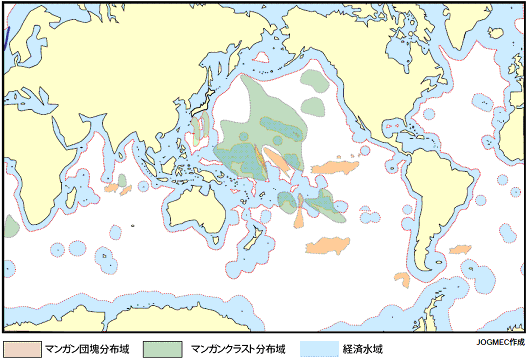/Image959.gif)
Figure 4. Idealized sketch profile of the Mn deposition (proximal
and distal facies) during Jurassic time: the oxidative bacterial
system cycle.
Proximal Mn facies and its environment:
1. Dissolved limestone footwall, sedimentary dikes, red-brown-green
lime marl and clay infillings, manganized limestone zones (black).
2. Cherty Fe and Mn oxide blocks (with high Sr-content) in varicoloured
metalliferous clay.
Distal Mn facies (close to source):
3. The flourishing of prokaryotic bacterial system, the bacteria-induced
precipitation of Mn and Fe in the form of metallic oxides.
4. MnOOH, FeOOH proto ore, green-clay (celadonite) formation,
phosphorite, organic matter (dead bacteria and other organisms)
and pyrite accumulation.
Distal Mn facies (far from the source, dissemination-contamination
of Mn on a large scale):
5. Mn nodules and encrustations, Mn or Mn-Fe hard grounds.
General key:
6. Triassic shallow-marine basement, platform.
7. Lower-Middle Liassic limestone (a), lime marl (b), shallow-marine
pelagic sequence.
8. Submarine (a) and terrestrial (b) volcanism in the surrounding
region (no direct connection with volcanic rocks known in the
studied area).
9. Reef.
10. Bio detritus (ammonites, brachiopods, molluscs, sponges,
crinoids, echinoids, ostracods, and fish remnants).
11. Planktonic organisms (radiolaria, foraminifera, and bositra).
12. Resedimentation.
Arrows show the direction of material flow. |
/Image960.gif)
Figure 5. Idealized profile of Mn deposition (proximal and
distal facies) during the Jurassic. Suboxic-reductive bacterial
system cycle. Diagenetic Mn carbonate ore formation.
1. Bacterially mediated consumption of organic matter (enzymatic
and total processes) by Mn4+, Fe3+, SO42-, e.g. diagenetic
MnCO3, Fe-nontronite-Fe-mica
(celadonite), pyrite (bacterial and inorganic), phosphorite formation.
Continuous clay formation with two levels of Mn carbonate mineralization.
2. Squares No. 1 and 2 show positions of Fig. 6 and 7. |
/Image984.gif)
/Image1996.gif)
/Image1997.gif)
/Image1998.gif)
/Image1999.gif)
/Image955.gif)
/Image982.gif)
/Image981.gif)
/Image980.gif)
/Image983.gif)
/Image959.gif)
/Image960.gif)
/Image957.gif)
/Image976.gif)
/Image961.gif)
/Image962.gif)
/Image964.gif)
/Image963.gif)
/Image958.gif)
/Image953.gif)
/Image978.gif)
/Image979.gif)
/Image952.gif)
/Image949.gif)
/Image950.gif)
/Image951.gif)
/Image977.gif)
/Image975.gif)
/Image954.gif)
/Image968.gif)
/Image967.gif)
/Image966.gif)
/Image965.gif)
/Image969.gif)
/Image970.gif)
/Image972.gif)
/Image971.gif)
/Image973.gif)
/Image974.gif)
/Image956.gif)
/Image985.gif)
/Image986.gif)

/Image947.gif)
/Image948.gif)
/Image946.gif)
/Image943.gif)
/Image944.gif)
/Image945.gif)